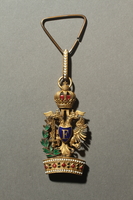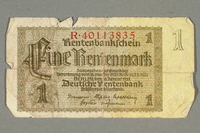Overview
- Date
-
undated:
- Credit Line
- United States Holocaust Memorial Museum Collection, Gift of Barbara Adler
Physical Details
- Classification
-
Identifying Artifacts
- Category
-
Badges
- Object Type
-
Star of David badges (lcsh)
- Physical Description
- Yellow felt badge in the shape of a 6 pointed Star of David. It is unused except for faint ink lines on the front.
- Dimensions
- overall: Height: 4.000 inches (10.16 cm) | Width: 3.375 inches (8.573 cm)
- Materials
- overall : felt
Rights & Restrictions
- Conditions on Access
- No restrictions on access
Administrative Notes
- Legal Status
- Permanent Collection
- Provenance
- The Star of David badge was donated to the United States Holocaust Memorial Museum in 2016 by Barbara S. Adler.
- Record last modified:
- 2022-07-28 18:13:43
- This page:
- https://collections.ushmm.org/search/catalog/irn543616
Download & Licensing
In-Person Research
- By Appointment
- Request 21 Days in Advance of Visit
- Plan a Research Visit
- Request to See This Object
Contact Us
Also in Denes and Janos Adler family collection
The collection consists of a World War I medal, scrip and currency, a Star of David badge, a tablecloth, albums, correspondence, documents, photographs, and a publication related to the experience of brothers Denes and Janos Adler, originally of Szeged, Hungary, and members of their extended families, as well as the family of Eva Timar Adler before, during, and after the Holocaust, when Denes emigrated before the war and Eva and Janos survived forced labor camps and emigrated to the United States following the war.
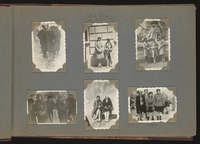
Adler family papers
Document
The Adler family papers document the Holocaust experiences of brothers Denis and János Adler, originally of Szeged, Hungary, and members of their extended families. The collection contains correspondence, biographical materials, immigration documents, restitution claims, and photographs regarding pre-war family lives; Denis’s emigration from Szeged in 1939; János’s conscription into the Hungarian Labor Service that accompanied German troops during the invasion of the Soviet Union, and his subsequent wounding and imprisonment in the field hospital in Alexajewka-Nikolajewka; the imprisonment and forced labor of Eva Adler, her mother Berta Neumann, and Borsca Adler in the Strasshof labor camp, Bergen-Belsen concentration camp, and Theresienstadt concentration camp; and post-war immigration to the United States. The biographical materials primarily contain birth, marriage, and death certificates; identification documents such as passports; employment records; and school records and diplomas. Other materials include documents related to Denis Adler’s medical profession in Szeged, Paris, and Los Angeles; János Adler’s brief name change to János Arató in 1946; accounting sheets of Eva Adler that likely represent clothing she made and sold; and records for the sale of a family property in Szeged in 1947. In addition, there are documents regarding Eva Adler, Borsca Adler, and Berta Neumann’s imprisonment in Theresienstadt concentration camp, and their repatriation from there to Szeged in late 1945. The bulk of the correspondence consists of letters exchanged among family members from 1938-1945. Many of the letters were received by Denis Adler, Lisa Timár, and Gyula Neumann, all of whom had arrived in the United States by 1941. The correspondence of Denis Adler also includes letters received by his brother János discussing family news and the conditions in Szeged in the fall of 1945; and letters by Raymonde Grumbach and Francois Moutier, both of whom were doctors Denis worked with while in Paris. The correspondence of Lisa Timár includes letters from János and Eva in Szeged to Lisa, 1937-1941; and extensive letters from her stepfather Gyula Neumann. Other correspondence includes postcards exchanged between János and Eva after János was conscripted into the Hungarian Labor Service and sent to Kunszentmiklós. There is also post-war correspondence of János from his former school friends and his teacher Jozsef Kerkai. The emigration and immigration papers primarily document János, Eva, and Borsca Adler’s efforts to immigrate to the United States after the war. Included are application materials, travel documents, and correspondence. There is also correspondence between Denis Adler and the United States Department of State on behalf of his mother, Borsca. The restitution claims contain records relating to the Adler family’s restitution claims through the Foreign Claims Settlement Commission of the United States, and the Austrian Reconciliation Fund. Included are applications, supporting documents, and correspondence. The photographs primarily document the Adler and Timár families’ pre-war lives in Szeged, but also include some wartime photographs and post-war depictions of family life in Szeged and the United States. The pre-war photographs include childhood photographs of Eva, Lisa, Denis, and János; various related family members; Jewish social events attended by Eva and Lisa; and Denis’s medical school. Wartime photographs include Denis with other doctors in Paris, aboard the S.S. Winnipeg, and in custody in Trinidad in 1941 while en-route to the United States; Janós with Jewish labor troops, likely in Kiszomber and Makó; and probably French prisoners in Szeged and Haag, Austria. Post-war photographs include Janós and Eva’s apartment in Szeged and various family members in the United States. The ephemera include a cookbook from Bergen-Belsen that was owned by Eva Adler, a prayer book in Hungarian, and a collection of writings that were likely authored by Lisa Timár.
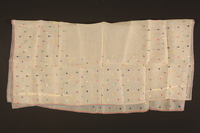
Embroidered tablecloth made in a forced labor camp
Object
Embroidered tablecloth made by Eva Timas in a forced labor camp in Hagg, Austria.
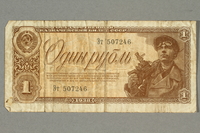
Soviet Union, one ruble note
Object

Soviet Union, one ruble note
Object
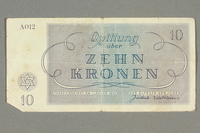
Theresienstadt ghetto-labor camp scrip, 10 kronen note
Object
Scrip, valued at 10 (zehn) kronen, of the type distributed in Theresienstadt (Terezin) ghetto-labor camp beginning in May 1943. The ghetto currency was printed by the National Bank in 7 denominations: 1, 2, 5, 10, 20, 50, 100. Inmates were not allowed to have currency, which was confiscated. The SS ordered the Jewish Council to design scrip for use only in the camp. It was issued to create a false appearance of normalcy. There was little to obtain with the scrip. Located thirty miles northwest of Prague in German occupied Czechoslovakia, the camp was established by the Germans in November 24, 1941, and ceased operation in early May 1945. In 3.5 years, approximately 140,000 Jewish persons were transferred to Terezin; nearly 90,000 were then deported, likely to their death, further east. About 33,000 died in Theresienstadt.
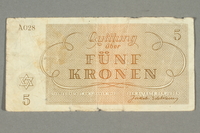
Theresienstadt ghetto-labor camp scrip, 5 kronen note
Object
Scrip, valued at 5 [funf] kronen, of the type distributed in Theresienstadt (Terezin) ghetto-labor camp beginning in May 1943. The ghetto currency was printed by the National Bank in 7 denominations: 1, 2, 5, 10, 20, 50, 100. Inmates were not allowed to have currency, which was confiscated. The SS ordered the Jewish Council to design scrip for use only in the camp, which was issued to create a false appearance of normalcy. There was little to obtain with the scrip. Located thirty miles northwest of Prague in German occupied Czechoslovakia, the camp was established by the Germans in November 24, 1941, and ceased operation in early May 1945. In 3.5 years, approximately 140,000 Jewish persons were transferred to Terezin; nearly 90,000 were then deported, likely to their death, further east. About 33,000 died in Theresienstadt.
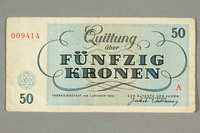
Theresienstadt ghetto-labor camp scrip, 50 kronen note
Object
Scrip, valued at 50 (funfzig) kronen, of the type distributed in Theresienstadt (Terezin) ghetto-labor camp beginning in May 1943. The ghetto currency was printed by the National Bank in 7 denominations: 1, 2, 5, 10, 20, 50, 100. Inmates were not allowed to have currency, which was confiscated. The SS ordered the Jewish Council to design scrip for use only in the camp, where it was issued to create a false appearance of normalcy. There was little to obtain with the scrip. Located thirty miles northwest of Prague in German occupied Czechoslovakia, the camp was established by the Germans in November 24, 1941, and ceased operation in early May 1945. In 3.5 years, approximately 140,000 Jewish persons were transferred to Terezin; nearly 90,000 were then deported, likely to their death, further east. About 33,000 died in Theresienstadt.
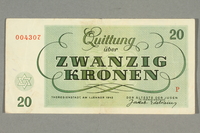
Theresienstadt ghetto-labor camp scrip, 20 kronen note
Object
Scrip, valued at 20 (zwanzig) kronen, of the type distributed in Theresienstadt (Terezin) ghetto-labor camp beginning in May 1943. The ghetto currency was printed by the National Bank in 7 denominations: 1, 2, 5, 10, 20, 50, 100. Inmates were not allowed to have currency, which was confiscated. The SS ordered the Jewish Council to design scrip for use only in the camp. It was issued to create a false appearance of normalcy. There was little to obtain with the scrip. Located thirty miles northwest of Prague in German occupied Czechoslovakia, the camp was established by the Germans in November 24, 1941, and ceased operation in early May 1945. In 3.5 years, approximately 140,000 Jewish persons were transferred to Terezin; nearly 90,000 were then deported, likely to their death, further east. About 33,000 died in Theresienstadt.
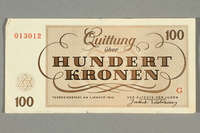
Theresienstadt ghetto-labor camp scrip, 100 kronen note
Object
Scrip, valued at 100 (ein hundert) kronen, of the type distributed in Theresienstadt (Terezin) ghetto-labor camp beginning in May 1943. The ghetto currency was printed by the National Bank in 7 denominations: 1, 2, 5, 10, 20, 50, 100. Inmates were not allowed to have currency, which was confiscated. The SS ordered the Jewish Council to design scrip for use only in the camp, where it was issued to create a false appearance of normalcy. There was little to obtain with the scrip. Located thirty miles northwest of Prague in German occupied Czechoslovakia, the camp was established by the Germans in November 24, 1941, and ceased operation in early May 1945. In 3.5 years, approximately 140,000 Jewish persons were transferred to Terezin; nearly 90,000 were then deported, likely to their death, further east. About 33,000 died in Theresienstadt.
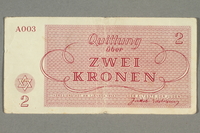
Theresienstadt ghetto-labor camp scrip, 2 kronen note
Object
Scrip, valued at 2 (zwei) kronen, of the type distributed in Theresienstadt (Terezin) ghetto-labor camp beginning in May 1943. The ghetto currency was printed by the National Bank in 7 denominations: 1, 2, 5, 10, 20, 50, 100. Inmates were not allowed to have currency, which was confiscated. The SS ordered the Jewish Council to design scrip for use only in the camp. It was issued to create a false appearance of normalcy. There was little to obtain with the scrip. Located thirty miles northwest of Prague in German occupied Czechoslovakia, the camp was established by the Germans in November 24, 1941, and ceased operation in early May 1945. In 3.5 years, approximately 140,000 Jewish persons were transferred to Terezin; nearly 90,000 were then deported, likely to their death, further east. About 33,000 died in Theresienstadt.

Theresienstadt ghetto-labor camp scrip, 1 krone note
Object
Scrip, valued at 1 (eine) krone, of the type distributed in Theresienstadt (Terezin) ghetto-labor camp beginning in May 1943. The ghetto currency was printed by the National Bank in 7 denominations: 1, 2, 5, 10, 20, 50, 100. Inmates were not allowed to have currency, which was confiscated. The SS ordered the Jewish Council to design scrip for use only in the camp. It was issued to create a false appearance of normalcy. There was little to obtain with the scrip. Located thirty miles northwest of Prague in German occupied Czechoslovakia, the camp was established by the Germans in November 24, 1941, and ceased operation in early May 1945. In 3.5 years, approximately 140,000 Jewish persons were transferred to Terezin; nearly 90,000 were then deported, likely to their death, further east. About 33,000 died in Theresienstadt.
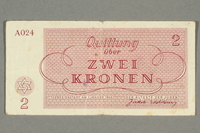
Theresienstadt ghetto-labor camp scrip, 2 kronen note
Object
Scrip, valued at 2 (zwei) kronen, of the type distributed in Theresienstadt (Terezin) ghetto-labor camp beginning in May 1943. The ghetto currency was printed by the National Bank in 7 denominations: 1, 2, 5, 10, 20, 50, 100. Inmates were not allowed to have currency, which was confiscated. The SS ordered the Jewish Council to design scrip for use only in the camp. It was issued to create a false appearance of normalcy. There was little to obtain with the scrip. Located thirty miles northwest of Prague in German occupied Czechoslovakia, the camp was established by the Germans in November 24, 1941, and ceased operation in early May 1945. In 3.5 years, approximately 140,000 Jewish persons were transferred to Terezin; nearly 90,000 were then deported, likely to their death, further east. About 33,000 died in Theresienstadt.

